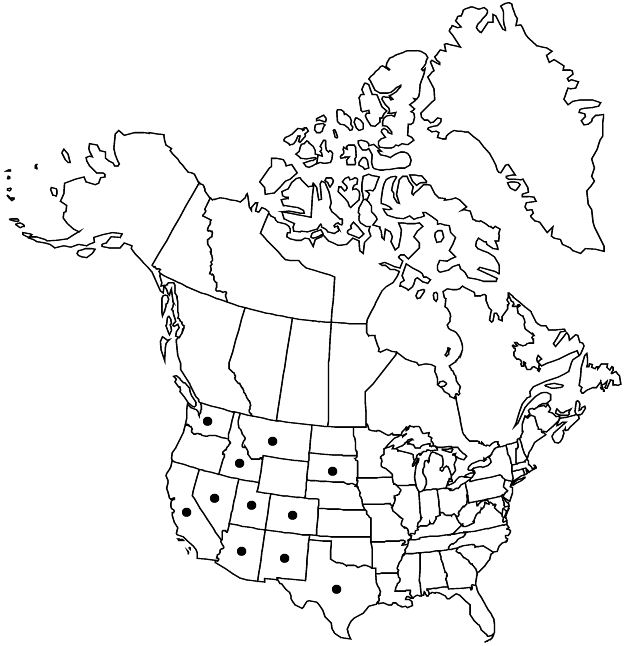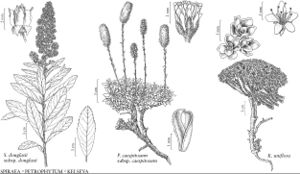Difference between revisions of "Petrophytum caespitosum subsp. caespitosum"
FNA>Volume Importer |
GeoffLevin (talk | contribs) (Added Wyoming to distribution; it is widespread there.) |
||
| (3 intermediate revisions by 2 users not shown) | |||
| Line 3: | Line 3: | ||
|accepted_authority= | |accepted_authority= | ||
|publications= | |publications= | ||
| + | |special_status={{Treatment/ID/Special_status | ||
| + | |code=F | ||
| + | |label=Illustrated | ||
| + | }} | ||
|basionyms= | |basionyms= | ||
|synonyms={{Treatment/ID/Synonym | |synonyms={{Treatment/ID/Synonym | ||
| Line 10: | Line 14: | ||
}} {{Treatment/ID/Synonym | }} {{Treatment/ID/Synonym | ||
|name=P. elatius | |name=P. elatius | ||
| − | |authority= | + | |authority=(S. Watson) A. Heller |
|rank=species | |rank=species | ||
}} {{Treatment/ID/Synonym | }} {{Treatment/ID/Synonym | ||
| − | |name=Spiraea caespitosa var. | + | |name=Spiraea caespitosa var. elatior |
|authority=S. Watson | |authority=S. Watson | ||
|rank=variety | |rank=variety | ||
| Line 30: | Line 34: | ||
|habitat=Dry rock ledges, rocky outcrops, talus slopes | |habitat=Dry rock ledges, rocky outcrops, talus slopes | ||
|elevation=1100–3000 m | |elevation=1100–3000 m | ||
| − | |distribution=Ariz.;Calif.;Colo.;Idaho;Mont.;Nev.;N.Mex.;S.Dak.;Tex.;Utah;Wash.;Mexico (Coahuila;Tamaulipas). | + | |distribution=Ariz.;Calif.;Colo.;Idaho;Mont.;Nev.;N.Mex.;S.Dak.;Tex.;Utah;Wash.;Wyo.;Mexico (Coahuila;Tamaulipas). |
|discussion=<p>Subspecies caespitosum is frequently found with relatively small leaves that are pilose to densely sericeous. Sometimes plants growing in moister conditions will have larger leaves and reduced indument, and they may develop visible primary and secondary venation.</p><!-- | |discussion=<p>Subspecies caespitosum is frequently found with relatively small leaves that are pilose to densely sericeous. Sometimes plants growing in moister conditions will have larger leaves and reduced indument, and they may develop visible primary and secondary venation.</p><!-- | ||
--><p>For this treatment, var. elatius has been subsumed in <i></i>subsp.<i> caespitosum</i>, as the author is uncertain as to whether it should be recognized as a variety within this subspecies or merits elevation to subspecies status. Variety elatius has short shoots with extended internodes (1–3 cm), larger panicles (10–20 × 8–15 cm), widely branched with 4–10 cm branches, with bracteoles linear to narrowly oblanceolate, 8–16 mm; it is found on dry rock ledges and outcrops, often on limestone, between 1100 and 2800 m in Arizona, <i>Nevada</i>, and Utah.</p><!-- | --><p>For this treatment, var. elatius has been subsumed in <i></i>subsp.<i> caespitosum</i>, as the author is uncertain as to whether it should be recognized as a variety within this subspecies or merits elevation to subspecies status. Variety elatius has short shoots with extended internodes (1–3 cm), larger panicles (10–20 × 8–15 cm), widely branched with 4–10 cm branches, with bracteoles linear to narrowly oblanceolate, 8–16 mm; it is found on dry rock ledges and outcrops, often on limestone, between 1100 and 2800 m in Arizona, <i>Nevada</i>, and Utah.</p><!-- | ||
| Line 45: | Line 49: | ||
|rank=subspecies | |rank=subspecies | ||
|parent rank=species | |parent rank=species | ||
| − | |synonyms=Petrophytum caespitosum var. elatius;P. elatius;Spiraea caespitosa var. | + | |synonyms=Petrophytum caespitosum var. elatius;P. elatius;Spiraea caespitosa var. elatior |
|basionyms= | |basionyms= | ||
|family=Rosaceae | |family=Rosaceae | ||
| Line 51: | Line 55: | ||
|habitat=Dry rock ledges, rocky outcrops, talus slopes | |habitat=Dry rock ledges, rocky outcrops, talus slopes | ||
|elevation=1100–3000 m | |elevation=1100–3000 m | ||
| − | |distribution=Ariz.;Calif.;Colo.;Idaho;Mont.;Nev.;N.Mex.;S.Dak.;Tex.;Utah;Wash.;Mexico (Coahuila;Tamaulipas). | + | |distribution=Ariz.;Calif.;Colo.;Idaho;Mont.;Nev.;N.Mex.;S.Dak.;Tex.;Utah;Wash.;Wyo.;Mexico (Coahuila;Tamaulipas). |
|reference=None | |reference=None | ||
|publication title= | |publication title= | ||
|publication year= | |publication year= | ||
| − | |special status= | + | |special status=Illustrated |
| − | |source xml=https:// | + | |source xml=https://bitbucket.org/aafc-mbb/fna-data-curation/src/2e0870ddd59836b60bcf96646a41e87ea5a5943a/coarse_grained_fna_xml/V9/V9_698.xml |
|subfamily=Rosaceae subfam. Amygdaloideae | |subfamily=Rosaceae subfam. Amygdaloideae | ||
|tribe=Rosaceae tribe Spiraeeae | |tribe=Rosaceae tribe Spiraeeae | ||
Latest revision as of 15:01, 1 November 2022
Short shoots usually compressed into tight rosettes, sometimes internodes extended and rosette structure lost. Leaf blades 0.4–1.4 cm, abaxial surface pilose to sericeous. Inflorescences compressed panicles, proximal 1/2 of panicle varying from unbranched with scattered bracts along peduncles to ± branched with branches 1–3(–4+) cm, distal 1/2 of panicle often appearing racemose with no or relatively few branches. Flowers: petal apex obtuse to slightly cleft.
Phenology: Flowering May–Oct.
Habitat: Dry rock ledges, rocky outcrops, talus slopes
Elevation: 1100–3000 m
Distribution

Ariz., Calif., Colo., Idaho, Mont., Nev., N.Mex., S.Dak., Tex., Utah, Wash., Wyo., Mexico (Coahuila, Tamaulipas).
Discussion
Subspecies caespitosum is frequently found with relatively small leaves that are pilose to densely sericeous. Sometimes plants growing in moister conditions will have larger leaves and reduced indument, and they may develop visible primary and secondary venation.
For this treatment, var. elatius has been subsumed in subsp. caespitosum, as the author is uncertain as to whether it should be recognized as a variety within this subspecies or merits elevation to subspecies status. Variety elatius has short shoots with extended internodes (1–3 cm), larger panicles (10–20 × 8–15 cm), widely branched with 4–10 cm branches, with bracteoles linear to narrowly oblanceolate, 8–16 mm; it is found on dry rock ledges and outcrops, often on limestone, between 1100 and 2800 m in Arizona, Nevada, and Utah.
Variety elatius appears to intergrade with subsp. caespitosum (freely intergrades; T. H. Kearney and R. H. Peebles 1942, 1960) but does not appear to be merely an ecological variant of it. Morphological work on the carpel of Petrophytum by C. Sterling (1966) indicated that, for the carpel characters examined, the character state distribution of P. elatius (here cited as var. elatius) was most similar to that of P. hendersonii. Variety elatius was dissimilar to both P. caespitosum (infraspecific taxon not identified, most likely subsp. caespitosum) and P. cinerascens. If var. elatius was only an ecological variant of P. caespitosum, it would be expected that carpel morphology and anatomy would be more similar than found by Sterling. Variety elatius may merit taxonomic recognition.
Selected References
None.
